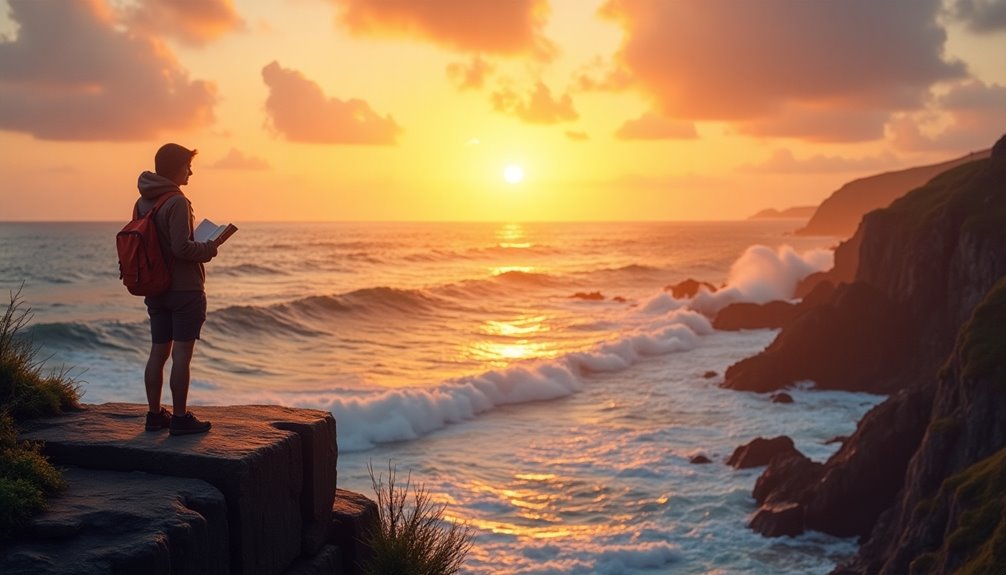To write engaging introductions for travel stories, start with a enthralling hook that grabs your reader's attention. Use vivid imagery and sensory language to paint a picture, touching on sights, sounds, and local flavors. Share a brief anecdote, perhaps a funny mishap or an unexpected moment that highlights the adventure ahead. Set the scene by providing context about the culture or geography, making readers feel absorbed in your journey. Mix in a bit of personal reflection to create emotional depth. With these elements, you'll draw readers in, leaving them impatient for what comes next in your travel tale.
Briefly keys
- Start with a captivating hook that sparks curiosity and draws readers into your travel experience.
- Use sensory language to create vivid imagery, immersing readers in the sights, sounds, and smells of the destination.
- Provide context about the location, including cultural significance and local customs, to enhance reader engagement.
- Share an anecdote or unexpected event that illustrates the essence of your journey and resonates with readers.
- Establish a conversational tone to mimic informal chats, making the narrative relatable and emotionally engaging.
Crafting a Captivating Hook
When it comes to travel writing, crafting an engaging hook is essential for drawing readers in at the very start. Think about using anecdotal examples that resonate with your audience.
Envision this: you're exploring a bustling market, the scent of spices filling the air, when a local vendor leans in and whispers, "You've got to taste this!" That's the kind of moment that not only captivates but also sets the tone for your adventure.
You can also start with sensory language. Describe the lively colors of fresh produce, the sounds of laughter echoing, or the warmth of the sun on your skin. This kind of vivid imagery transports readers straight into your experience, creating an emotional connection right away. Effective storytelling is crucial in travel writing, as it helps maintain readers' interest throughout your narrative.
Don't forget to introduce a bit of tension or intrigue. Maybe you're lost in the maze of stalls, and you wonder whether you'll ever find your way out.
That question invites readers to stick around for the answer. By weaving together these elements, you'll create a hook that's not just engaging but also memorable, ensuring your travel story stands out in a crowded field.
Setting the Scene Effectively
Once you've captured your reader's attention with an engaging hook, the next step is to set the scene effectively. You want to create an atmosphere that envelops your reader, pulling them into the moment.
Use sensory immersion to paint a striking picture. Describe the lively colors of the landscape, like the deep greens of the forest or the golden hues of a sunset. Let them hear the sounds around you—the rustling leaves, the distant laughter, or maybe even the hum of a bustling market. Including unexpected events during travel can also enhance the narrative and engage the reader.
Don't forget the smells. Is it the fresh aroma of local cuisine wafting through the air, or perhaps the sharp scent of gasoline at a rugged roadside diner?
Feel the environment, too; is the sun beating down on your skin, or is a cool breeze sending shivers down your spine?
And taste? Share that first bite of a spicy street taco that dances on your tongue.
Through your character's eyes, their emotions should resonate with the setting, revealing their thoughts and feelings. This connection makes your scene not just a backdrop, but a living part of the story.
Providing Context and Background

To genuinely envelop your readers in your travel story, providing context and background is essential. Start by giving your audience a vivid picture of your destination. Describe the geographical significance of the area—maybe it's situated between majestic mountains or sprawled along a sun-kissed coast. Mention the climate and season; is it sweltering summer, or are you enjoying a crisp autumn day? These details create a sense of place.
Next, immerse yourself in local customs and traditions to enhance their cultural immersion. Share anecdotes about interactions with locals, highlighting their warm smiles or unique ways of life. Don't forget to sprinkle in some history, perhaps touching on significant events that shaped the area. You could even mention local foods or festivals that set the scene, making readers feel like they're right there with you. Engaging narratives often use the anecdote technique to connect with readers on a personal level.
Finally, explain why this location matters to you. What're you hoping to discover or learn? Your perspective won't only provide depth but also draw readers in, making them enthusiastic to join you on this journey.
Developing a Compelling Narrative
Crafting a compelling narrative is the heartbeat of any travel story, pulling readers into your journey out of the very first word. Start with a strong hook—a question that sparks curiosity or a vivid description of a moment that sets the scene. Jump right into the action; you want readers to feel the excitement or tension at the outset.
As you build your story, focus on character development. Share your experiences and interactions with locals, revealing personal growth and insights along the way. Use narrative techniques like dialogue to add authenticity, allowing readers to connect with your journey on a deeper level. Travel writing often documents human experiences, enriching the narrative with shared moments and cultural reflections.
Don't forget to maintain a coherent structure with a clear beginning, middle, and end. Each segment should contribute to the overall theme, whether it's adventure, culture, or self-discovery. Sprinkle in sensory details; let readers smell the spices in a market or hear the laughter of children playing.
Finally, guarantee your climax is compelling, resolving the action or illuminating a key idea. By weaving these elements together, you'll create a narrative that not only informs but also captivates your audience.
Integrating Description and Reflection

Integrating vivid description with personal reflection transforms a simple travel narrative into an immersive experience. When you weave sensory immersion into your writing, the reader feels like they're right there with you. Envision the eerie crackling of ice beneath your feet or the smell of night-blooming jasmine wafting through an open window.
By sharing personal anecdotes about these moments, you invite readers to connect on a deeper level. For instance, recounting how dark mud oozed into your sandals during a daybreak hike can evoke laughter and understanding, while the taste of rich coffee and ripe mango adds delicious depth to your tale. This element of storytelling is especially vital in travel writing, as it encourages exploration of local culture and fosters a connection to the places you visit.
Don't shy away from reflecting on what each experience means to you. Maybe you spilled wine while climbing steps to a viewing balcony, foreshadowing the excitement of the event. Such moments highlight personal growth and create a richer narrative.
Interacting with locals can also add texture, as their dialogue reveals not just their character but the heart of the place. By blending sensory details with your reflections, you create a dynamic fabric that captures the essence of your journey, making readers enthusiastic to follow along.
Keeping Readers Engaged
How do you guarantee that your travel stories resonate with readers long after they've turned the page? To keep them engaged, think about incorporating interactive storytelling elements that invite readers into your journey.
Start with a compelling anecdote or a vivid description that pulls them right into the action. Imagine this: you're in a bustling market, the air thick with spices, and the sounds of haggling surround you. Wouldn't you want your readers to feel that moment too?
Next, build an emotional connection by sharing personal revelations. When you reveal your feelings during challenges or joyful encounters, it's like you're inviting readers to walk alongside you. Use rich sensory details that appeal to sight, sound, and even taste—this envelops them completely in your narrative. Incorporating cultural insights can deepen the connection by providing context about the experiences you're sharing.
And remember, a conversational tone can make a world of difference. It's like chatting with a friend over coffee, making your story relatable and enjoyable.
Ending With Impactful Insights

As one wraps up their travel story, think about the lasting impression you want to leave behind. You could use a powerful anecdote, like the time you shared a meal with locals who welcomed you with open arms. This not only highlights cultural discoveries but also showcases the warmth and hospitality of the people you encountered.
Vivid descriptions of the food, laughter, and conversations create imagery that lingers in the reader's mind. Additionally, consider how your experience in Afghanistan's natural splendor might inspire others to explore destinations often overlooked.
Don't forget to reflect on any lessons learned. Maybe you discovered a newfound respect for different customs or found that travel can break down stereotypes. Ending with a thought-provoking question can keep your audience engaged. For instance, ask them how their perceptions of a culture might shift after hearing your story.
You might also want to share tips for fellow travelers or recommend books that deepen their understanding of the places you've visited.
Ultimately, your travel experience is about personal growth, so convey how it broadened your outlook on life. By ending with impactful insights, you guarantee your story resonates long after the last word is read, sparking inspiration for future adventures.
Wrapping up
So, next time you're spinning a travel tale, remember that a great intro sets the tone. Did you know that 80% of readers decide whether to keep reading within the first few sentences? That's right! If you hook them early, you're already halfway there. By painting a vivid picture and weaving in your unique experiences, you'll not only keep them engaged but also inspire wanderlust. Now, go on and share your adventures—who knows who you might inspire!